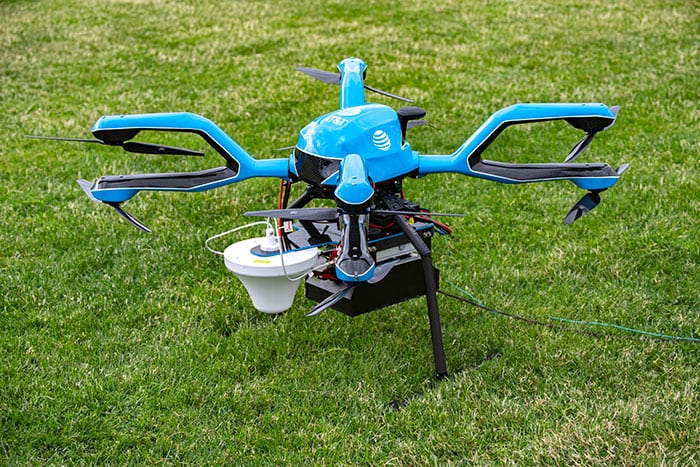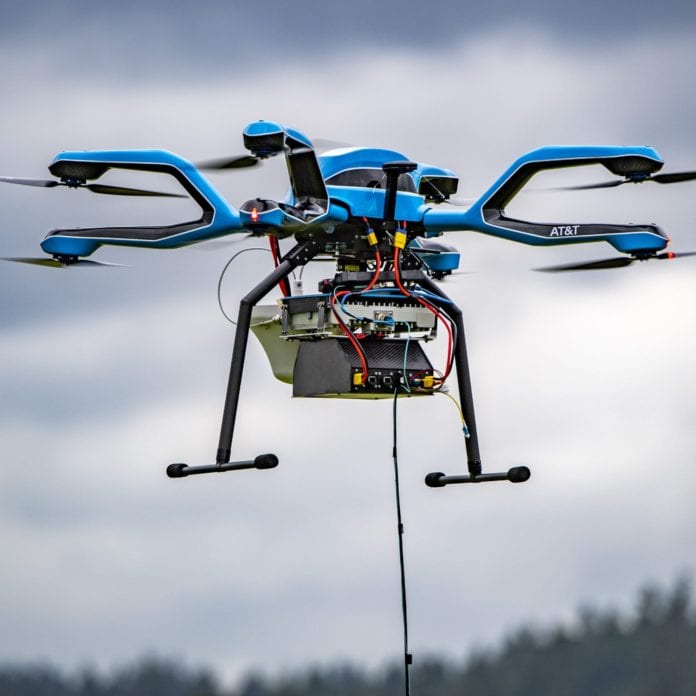Able to fly in tough conditions, AT&T’s all-weather Flying COW drone will help first responders, FirstNet.
AT&T has designed an all-weather drone to keep its wireless network “flying” in a disaster. The all-weather Flying COW drone — designed by AT&T with help from manufacturers and first responders — will be one of two types of drones that AT&T will offer for its Network Disaster Recovery (NDR) system.
AT&T designed the “Extreme-Weather Drone” to be able to fly through rain or snow and handle tropical wind gusts up to 50 mph. It can handle extreme temperatures (both hot and below freezing).
“This is an octocopter drone – a multi-rotor. Four arms with eight rotors on it,” Art Pregler, AT&T’s unmanned aircraft systems (UAS) program director, told RCR Wireless News.
The all-weather Flying COW drone was designed by AT&T working with manufacturers. The drone was built by AT&T in public-private partnership with the First Responder Network Authority (FirstNet), which has contracted with AT&T to provide a nationwide public safety network for first responders.
“Unlike a lot of drones where the drone manufacturer comes up with a drone design and then they try to weather-proof it as an afterthought, this drone was designed as an all-weather drone from the initial paper,” says Pregler. “The motors are facing down, the way the air flows through it, even inside of it — the tubes of the structure itself …. Thought was put into the temperatures that it would be operating in, the rain conditions, the snow conditions. It was optimized for that purpose.”
The drones come equipped with small cells and antennas. It’s compactness makes it easy to transport and deploy, claims AT&T, adding that it can be “moved quickly to accommodate rapidly changing conditions in an emergency.”
That includes rapidly changing network conditions within the A&T network, Pregler said.
“Drones, I believe, are going to have an increasing role in communications networks,” Pregler explained. “Right now, the way we are using them as terrestrial COWs, traditional COWs — but putting them on drones, putting them on tethers to augment that. We believe they will become, over time, more integrated with the network so that as the network determines additional capacity or coverage is needed throughout each given day, drones could be deployed from cell towers to these locations to provide that temporary extra capacity. When the network determines that capacity is no longer needed, the drones could return back to the cell towers to recharge and await their next mission as autonomously directed by the network itself.
“We are still a few years away from that,” Pregler added.
AT&T worked with manufacturers and third party vendors to make the drone. “We looked to see what was in the marketplace and we selected what we believed to be the best platform out there,” Pregler told RCR Wireless News. “And then we reached out to the manufacturer and said, ‘based on this platform we would also like these capabilities.’ And so, [we] worked with the manufacturer to add additional capabilities to the platform. We also brought in third party vendors to work on the platform as well to add more capabilities to it as well.”
The Extreme-Weather Drone took its first flight last week in Bedminster, New Jersey and was also flown by University of Washington engineering students in Redmond, Washington. The students tested LTE antennas they designed to connect on the AT&T drones. The antenna development and test flight was the first time the new all-weather flying COW took on live LTE test traffic, according to Pregler’s blog.
When asked how many of the all-weather drones would be deployed in AT&T’s Flying COW system, Pregler old RCR Wireless News that “We are still defining that.”
“What we do plan to do is deploy two types of drones and this [Extreme-Weather Drone] is one of them through our Network Disaster Recovery Team,” Pregler explained. “We are going to stage these at each of the NDR operations centers across the U.S. The operations centers are already strategically located so they can get to where disasters tend to occur in the minimum amount of time. And we have a large amount of various types of network equipment there ready to go.”

AT&T is adding the drones to all their stored network equipment in the NDR operation centers so “they can be deployed rapidly.”
“From there we may select additional locations to put drones depending on the operational requirements and response times,” said Pregler.
AT&T’s flying COW system tethers the drone to the ground with a thin fiber cable that feeds power and signal to the airborne drone, which then sends the signal out over the air to customers. AT&T last year got FAA approval to fly its over-55-lb flying COWs in Puerto Rico to help customers and officials after Hurricane Marie devastated the country. (Under FAA’s Part 107 rules, 55 lbs is the payload limit. AT&T got the FAA waiver because the flying COWs carried over the limit.) The flying COWs provided data, voice, and text services to customers and recovery teams in Puerto Rico and carried dozens of gigabytes of data, and thousands of calls and texts, says Pregler in his blog.
Because the drone can see through smoke and foliage, one use case for the drone is to maintain a network for firefighters out in a rural area, where they are fighting a fire. The network would help the firefighters stay better connected to each other. The drone also has thermal imaging built in to enable it to see into some structures to help identify what areas are unsafe for firefighters. The thermal imaging can help with search and rescue also.
AT&T’s Art Pregler is unconcerned if copy-cats use AT&T’s ideas for the all-weather model. “If it helps people when disaster strikes and they need connectivity, this [drone] is helping getting families back online, helping first responders, if our competition is doing it as well, if they adopt the models that we created, I am fine with that as well,” he said. “But we are going to continue to evolve our model, so we are definitely not standing still. Everything we deploy, we have something else on paper that is going to evolve and keep it going to the next level.”

